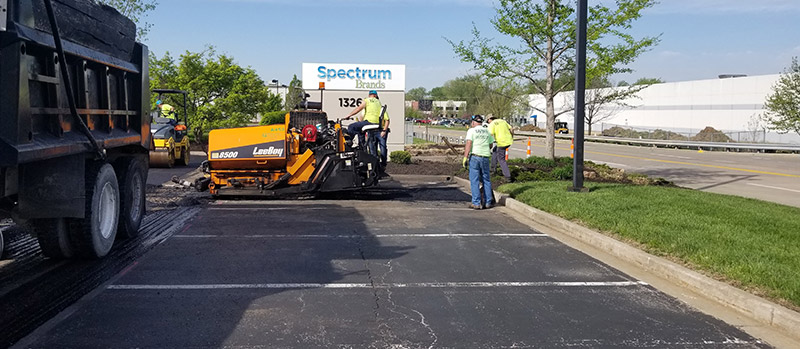The smart Trick of A1 Professional Asphalt & Sealing Llc That Nobody is Talking About
The smart Trick of A1 Professional Asphalt & Sealing Llc That Nobody is Talking About
Blog Article
The 30-Second Trick For A1 Professional Asphalt & Sealing Llc
Table of ContentsFascination About A1 Professional Asphalt & Sealing LlcA1 Professional Asphalt & Sealing Llc for BeginnersThe Main Principles Of A1 Professional Asphalt & Sealing Llc A1 Professional Asphalt & Sealing Llc for DummiesThings about A1 Professional Asphalt & Sealing Llc

The oil in a car engine is not simply oil. It consists of a selection of ingredients to enhance the lorry's efficiency. These include polymers, thickness modifiers, heat stabilizers, extra lubes, and put on additives. The REOB contains all the ingredients that were in the waste oil in addition to the wear metals from the engine (generally iron and copper).
Nonetheless, by making several blends using different REOB examples and various asphalt binders, the variants greatly can be averaged out. A number of States gave examples of known REOB composition to TFHRC researchers, who assessed the samples to contrast the percentage of added (known) REOB to the found (evaluated) amount. The analyses showed a similar portion of added and discovered REOB.
A1 Professional Asphalt & Sealing Llc Fundamentals Explained
They obtained a frustrating response. The TFHRC researchers analyzed 1,532 examples from 40 States, one Canadian province, and two Government Lands Highway divisions. They examined each example twiceamounting to more than 3,000 analyses. None of those States understood that the asphalt they were purchasing included REOB. One State urged its examples had no REOB.
Of the 1,532 examples evaluated, 12 percent had REOB, and some contained substantially high levels of it at 1020 percent. The highest level was 34 percent in a sample from Texas, which TxDOT had used in a patching compound. This screening additionally revealed the existence of phosphoric acid in 11 percent of the examples, and 2 percent included ground tire rubber.
Two years earlier at TRB's annual meeting, the Federal researchers held an REOB workshop and presented the searchings for of their lab analyses to a standing room-only crowd. Although some agencies do not especially prohibit REOB, they do impose physical examinations that prevent its useeffectively a restriction. asphalt repairs. Others do not outlaw it by requirements, however have contracts with asphalt providers to stay clear of the use of REOB
Indicators on A1 Professional Asphalt & Sealing Llc You Need To Know
A handful do enable REOB, some within specific limits. For instance, Ohio and Texas limitation levels to less than 5 percent of the asphalt. To develop a trusted test approach that all States can use, the TFHRC scientists established a round-robin examination strategy. The individuals are 11 State highway agencies (Illinois, Massachusetts, Minnesota, Mississippi, Montana, North Carolina, Oklahoma, South Carolina, Texas, Vermont, and Wyoming), 2 independent screening laboratories, the Ministry of Transport in Ontario, Queen's College in Ontario, and an Ontario paving professional.
The individuals are evaluating the samples independently using the standards given by the TFHRC scientists. The outcome will be a recommended AASHTO examination approach that any type of State can adopt and make use of.
The sidewalk with REOB, which lies 0.6 mile (1 kilometer) from the pavement without REOB, has the same subgrade, web traffic density, and environment. Nonetheless, the section of Highway655 with 5 to 10 percent REOB showed substantial cracking. In this instance, the presence of REOB was the recognized reason of cracking at a low temperature levels.
An area of test pavement in Minnesota (MN1-4) located to consist of REOB also fractured prematurely. The sidewalk done well for the initial 3 to 4 years, but then why not try these out began to fracture.
What Does A1 Professional Asphalt & Sealing Llc Do?
The examinations were not substantial, but they revealed that at levels of 6 percent or even more, the tensile strength of the asphalt dropped dramatically. At a degree of 3.5 percent REOB, the variant in the physical examination approaches was more than the impact of REOB. In truth, it was hard for scientists to analyze whether REOB existed.

One binder criterion taken into consideration is the distinction between the reduced temperature vital specification temperature level for tightness (S) in the bending light beam rheometer and the flexing beam rheometer creep incline (m-value) kept in mind as Tcritical. Two independent research teams, one from AASHTO and the various other from the Asphalt Institute, ended that more research is required on the usage of REOB in asphalt.
Previously, all asphalt screening determined engineering residential properties such as rigidity. These tests do disappoint what materials had actually been included to the asphalt. One example obtained during the TFHRC research had an extremely strange evaluation. The example had the complying with examination results: Superpave PG 64-28 with a high temperature level grade of 67.3 Tcritical on the flexing beam rheometer was 6.7 levels Celsius.

A1 Professional Asphalt & Sealing Llc Can Be Fun For Everyone
These outcomes show there are weaknesses in the standard design screening protocols that might be manipulated. The manufacturer might have an economic benefit and the item passes all the standard tests, but the item might not be valuable to making certain lasting performance. To address this concern and the development of new asphalt additives and extenders, TFHRC is beginning a research study program to utilize handheld spectroscopic tools, x-ray fluorescence spectroscopy, and Fourier change infrared spectroscopy to allow analyses to be carried out in the area instead of having to take examples back to the lab.
Report this page